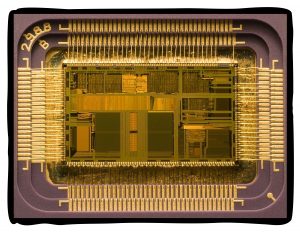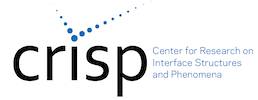Our kits are currently being reviewed and updated by a team of collaborative, innovative and interdisciplinary educators who wish to enhance the educational opportunities for students. These dedicated teachers are members of CRISP Collaborative Science for All (CCSA) as well as local educators.
Click to see the SCSU CRISP Module Template used by CCSA for improving and updating the CRISP demos and kits. Each kit page offers a CRISP developed teacher module and CRISP aligned standards (both NGSS and CCSS)
Kit Request form

This is a photo of the Intel 486 chip introduced in the early 1990s. This was the first chip to have more than a million transistors. This photo is magnified 40 times, however, even at that magnification it is difficult to see the tiny wires on the chip, which is the rectangle in the center.
Yesterday’s room-sized supercomputers are today’s miniature microchips. Today’s smaller devices are more portable, cost less to make, consume less power, and have longer-lasting batteries. But how small can we go? How much power and performance can we squeeze out of ever-shrinking microchips?
Adapted from Making Stuff Smaller by NOVA via the Making Stuff project
Subject(s):
Properties at the Nanoscale, measurement, Computers
Objectives:
Students will understand how challenging it is to work on the small scale
That materials scientists are developing extremely small, thin wires, called nanowires, that may help make computers and electronics even smaller in the future
Materials in this kit:
- 12 pipe cleaners, silver or gold tinsel, cut to 4″ lengths
- 1 block** of green floral Styrofoam®, 4″ wide x 4″ long x 2″ high
- 2 smaller green floral Styrofoam® blocks (e.g., 2″ x 2″, and 1″ x 1″)
- 1 dime
- Photos (See additional resources)
- Various outdated electronics
Suggestions for the Teacher:
Safety:
- Have your students put on safety goggles.
- Be sure the students use caution when using the scissors and/or utility knife
Additional Resources:
Making Stuff Smaller Guide from NOVA
Applications of Nanowires (photo) from NOVA
Circuit Board from NOVA
Inside of a Microchip from NOVA
Microscopic image of wires on a microchip from NOVA
Microchip on a fingertip from NOVA
Nanowire compared to a single strand of hair from NOVA
Making Stuff Website
Making Stuff Smaller
NOVA
STEM Careers:
Standards:
MS-PS1-3 Matter and its Interactions
Gather and make sense of information to describe that synthetic materials come from natural resources and impact society.
HS-PS1-3 Matter and its Interactions
Plan and conduct an investigation to gather evidence to compare the structure of substances at the bulk scale to infer the strength of electrical forces between particles.
MS - PS1.A: Structure and Properties of Matter
Substances are made from different types of atoms, which combine with one another in various ways. Atoms form molecules that range in size from two to thousands of atoms.
Solids may be formed from molecules, or they may be extended structures with repeating subunits (e.g., crystals).
HS-PS1.A: Structure and Properties of Matter
The structure and interactions of matter at the bulk scale are determined by electrical forces within and between atoms.
MS – CC 6 - Structure and Function
Structures can be designed to serve particular functions by taking into account properties of different materials, and how materials can be shaped and used.
HS CC1 - Patterns
Different patterns may be observed at each of the scales at which a system is studied and can provide evidence for causality in explanations of phenomena.
MS SEP 8 - Obtaining, Evaluating, and Communicating Information
Gather, read, and synthesize information from multiple appropriate sources and assess the credibility, accuracy, and possible bias of each publication and methods used, and describe how they are supported or now supported by evidence.
HS SEP 3 – Planning and Carrying out an investigation
Plan and conduct an investigation individually and collaboratively to produce data to serve as the basis for evidence, and in the design: decide on types, how much, and accuracy of data needed to produce reliable measurements and consider limitations on the precision of the data (e.g., number of trials, cost, risk, time), and refine the design accordingly.
Suggested Video(s):
http://www.pbs.org/wgbh/nova/tech/making-stuff.html#making-stuff-smaller
